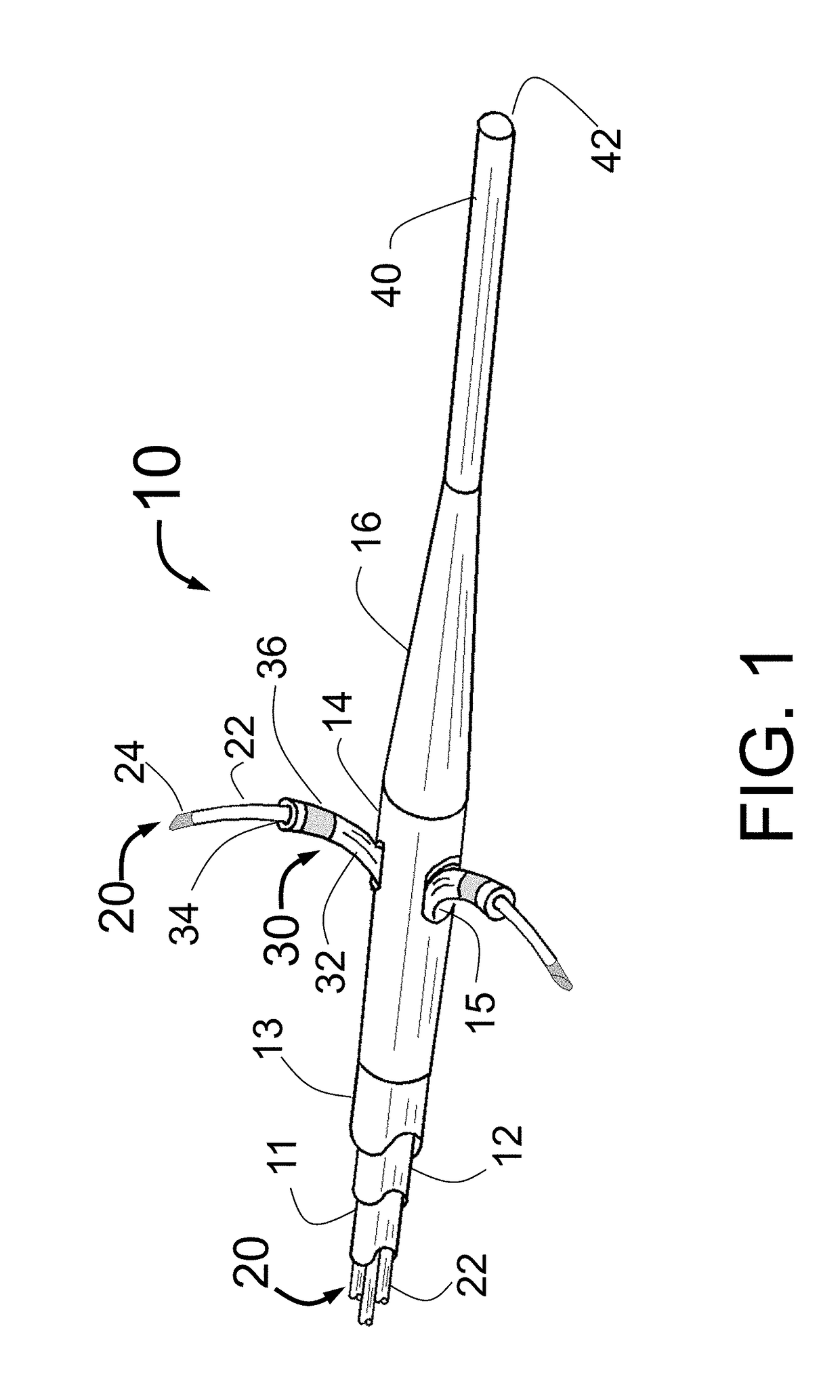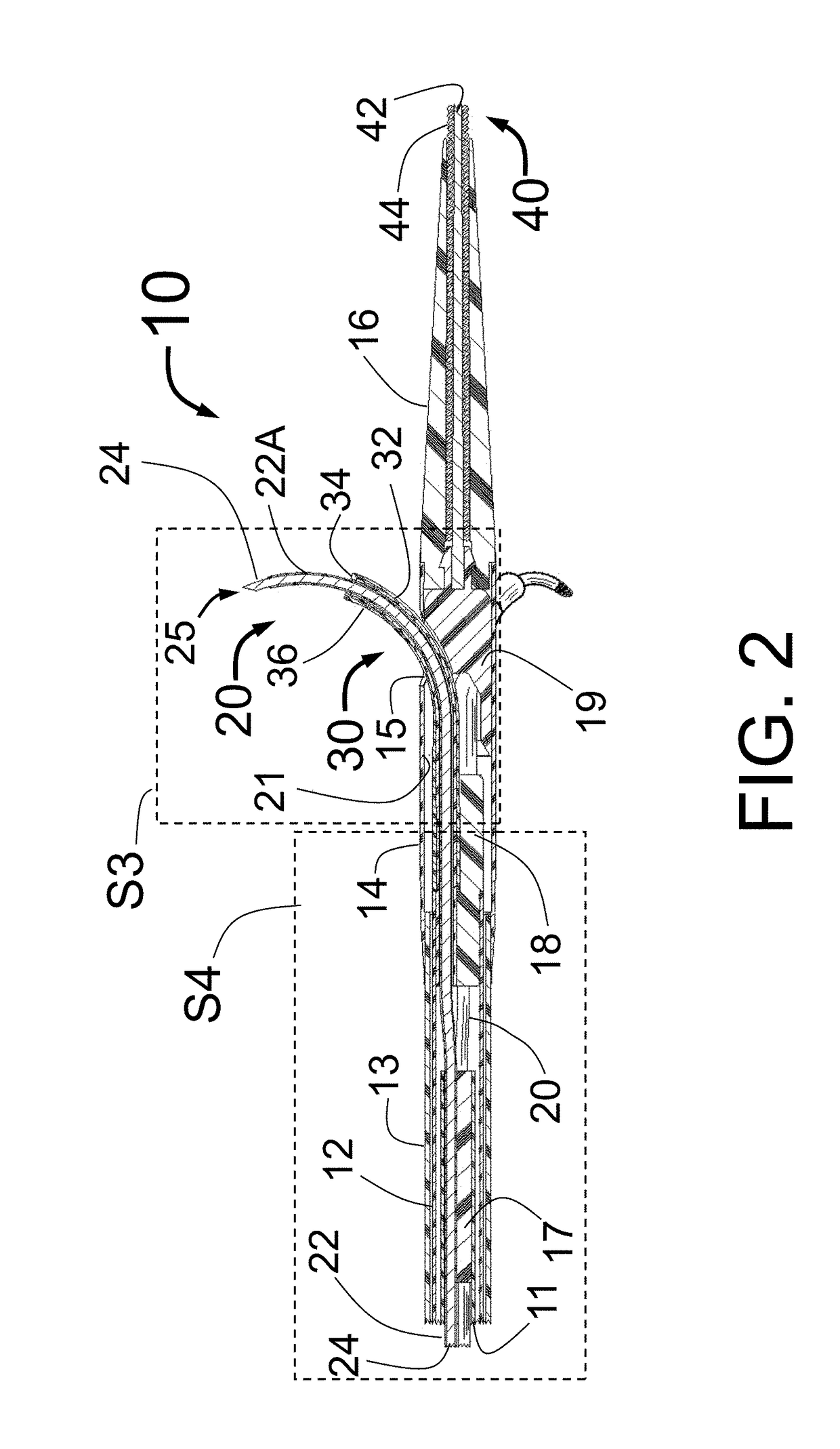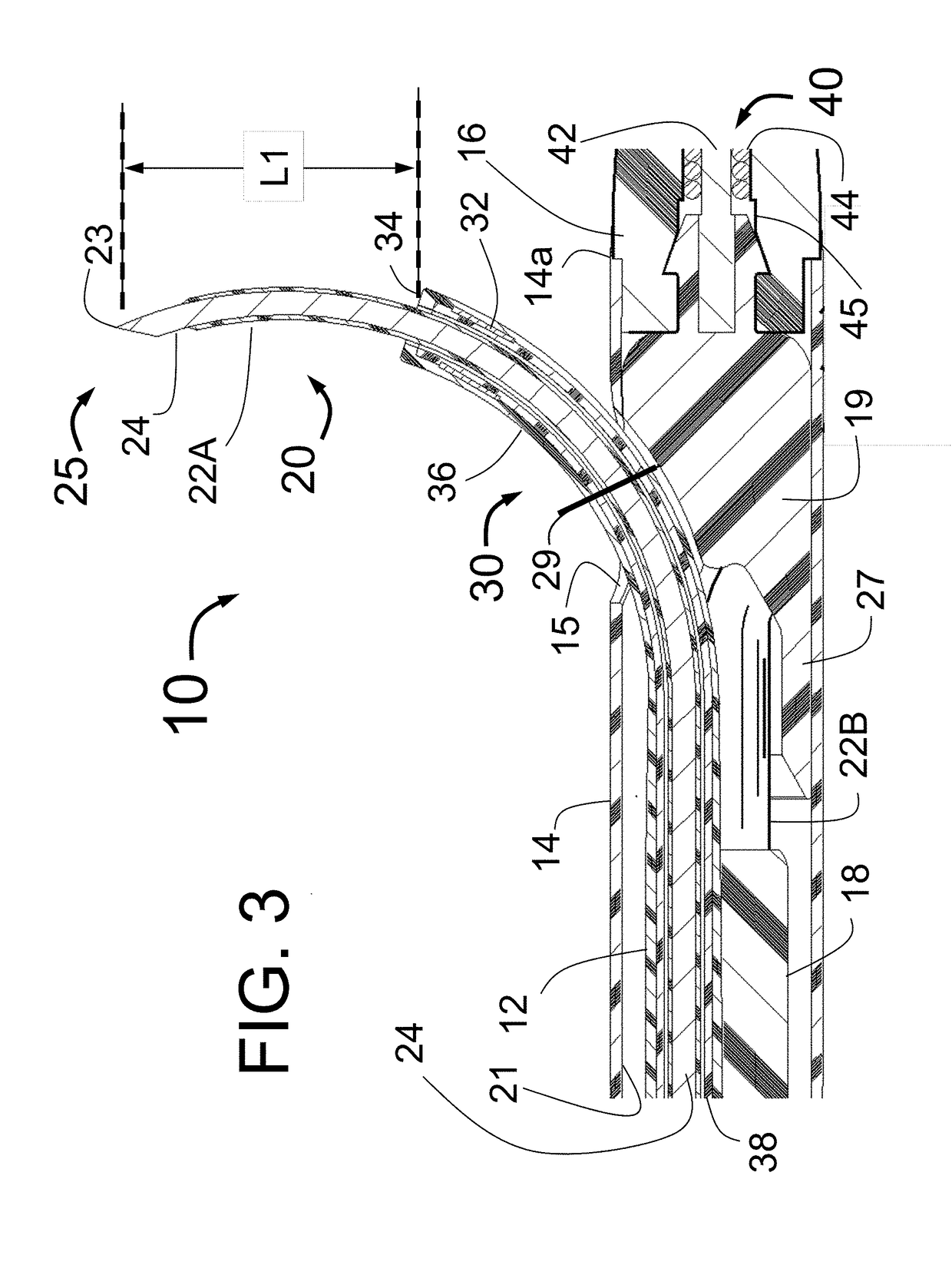However, in order for the procedure to be successful, renal nerves need to be sufficiently ablated such that their activity is significantly diminished.
A significant drawback of
ablation procedures is the inability for the physician performing the procedure to ascertain during the procedure itself that the
ablation has been successfully accomplished.
Furthermore, procedural success with currently available devices is far from universal.
Since the
blood pressure lowering effect of the treatment often does not occur immediately, the
blood pressure measured in the catheterization laboratory cannot act as a measure to guide to the technical success of the procedure.
There may also be uneven or incomplete
sympathetic nerve ablation, particularly if there are anatomic anomalies, individual variation in characteristics such as wall depth or distance of nerves from the inner wall, or atherosclerotic or fibrotic
disease in the intima of the renal artery, the result being that there is non-homogeneous or otherwise ineffective delivery of RF energy.
This could lead to treatment failures, or the need for additional and potentially dangerous levels of RF energy to ablate the nerves that run along the adventitial plane of the renal artery.
Similar safety and
efficacy issues may also be a concern with the use of
ultrasound or other type of energy used for ablation when this is provided from within the vessel wall.
The Simplicity™
system for RF delivery, like other
energy based systems, applies energy to the intimal surface of the artery in a spiral pattern because intraluminal circumferential ablation would result in a higher risk for permanent arterial damage leading to renal artery
stenosis or perforation.
The “burning” of the interior wall of the renal artery using
RF ablation can be extremely painful during the procedure.
This is especially difficult to affect with any
energy based system operating from inside the renal artery because the C-fibers, which are the pain nerves, are located within or close to the
media layer of the artery.
Thus, there are numerous and substantial limitations of the current approach using RF-based renal sympathetic
denervation.
Similar limitations apply to
ultrasound or other
energy delivery techniques which are delivered from within the renal artery.
Accordingly, the incorporation of three needles would likely be impossible to realize using the technology disclosed in that prior art.
If only one needle is used, controlled and accurate rotation of any device at the end of a
catheter is difficult at best and could be risky, inaccurate, and therapeutically ineffective if the subsequent injections are not evenly spaced.
This device also does not allow for a precise, controlled and adjustable
penetration depth (i.e. relative to the wall surface) of delivery of a neuroablative agent.
The physical constraints regarding the length that can be used, thus limits the ability to inject agents to an adequate depth outside of the
arterial wall, particularly in diseased renal arteries with thickened intima.
Another limitation of the
Bullfrog® is that inflation of a
balloon within the renal artery can induce transient renal
ischemia during the operation and possibly late vessel
stenosis due to
balloon injury of the intima and media of the artery, as well as causing endothelial
cell denudation.
Using a hilt that has a greater
diameter than the tube, suffers the
disadvantage that it increases the device profile, and also prevents the needle from being completely retracted back inside the tubular shaft from which it emerges This design requires keeping the needles exposed and potentially allowing accidental needlestick injuries to occur, during either
catheter removal after the ablation procedure is completed, during any rotation which is desired during the procedure, or when moving from one target location to the next.
For either the renal denervation or
atrial fibrillation application, the length of the needed catheter would make control of such rotation difficult.
Longer penetration depths that are needed to provide the
advantage of extending beyond the
adventitia to the location of the sympathetic nerves outside of the renal artery would greatly increase the
diameter of the Jacobson catheter thereby making
insertion of the catheter tip problematic and needlestick injuries even more likely.
There is also no mechanism that would provide for the adjustment of
penetration depth which may be important if the clinician wishes to selectively target a specific layer in a vessel or penetrate all the way through to the volume of tissue outside of the
adventitia in vessels that may have different wall thicknesses.
Many of the limitations of Jacobson may be due to the fact that Jacobson does not envision use of the injection catheter for denervation.
Both of these design limitations make advancement through the vascular
system more difficult.
Lastly, because of the hilts used by Jacobson, if the needles were withdrawn completely inside of the sheath they could get stuck inside the sheath and be difficult to
push out during the intended deployment at the target area.
The above listed limitations and complexity of the Jacobson system might increase the risk of surgical complications and inadequate, or incomplete, renal denervation.
The McGuckin device has an open distal end that does not provide protection from inadvertent needle sticks from the sharpened tines.
To achieve such strength, the tines would have to be so large in
diameter that severe extravascular bleeding would likely often occur when the tines would be retracted back following
fluid injection for a renal denervation application.
Further, there is no workable penetration limiting mechanism that will reliably set the
depth of penetration of the distal opening from the tines with respect to the interior wall of the vessel, nor is there disclosed a preset adjustment for such depth.
The limitation of the needle alone designs are that if small enough diameter needles are used to avoid unwanted
surgical results such as
blood loss following penetration through the vessel wall, then the needles may be too flimsy to reliably and uniformly expand to their desired positions.
Without predictable catheter centering and
guide tube expansion it may be challenging to achieve accurate and reproducible
needle penetration to a targeted depth.
While the prior art has the potential to produce ablation of the sympathetic nerves surrounding the renal arteries and thus produce desired therapeutic effects such as reducing the patient's
blood pressure, none of the prior art includes sensors (e.g. extravascular sensors) or additional systems to monitor the activity of the sympathetic nerves being ablated.
The NSC requires a separate renal denervation device be used to provide ablation, but has a large
potential market when used in combination with other, potentially less effective and less predictable renal denervation devices, such as those that ablate nerves using RF energy from intravascular sites.
Various scientific articles have described methods of measurement of
nerve activity, yet these have not disclosed obtaining measurements perivascularly from a catheter with sensor that pierce the vessel wall.
Without additional guiding (support) during advancement, needles that are thin enough to not cause
blood loss following withdrawal from the wall of the artery are generally too flimsy to reliably penetrate as desired into the vessel wall.
Current
medical therapy has significant side effects because of the systemic effects of these medications.
Conventional intravascular
energy delivery by
ultrasound or RF will ablate tissue from the
endothelium (the inside layer) of the artery all the way to the adventitia, thus damaging both unmyelinated “C-fibers” causing pain as well as a portion of the
sympathetic nerve fibers.
Intravascular
energy delivery may be limited in
efficacy as it is limited in its ability to ablate the sympathetic nerves outside of the adventitia without causing irreparable damage to the artery.
 Login to View More
Login to View More  Login to View More
Login to View More 


